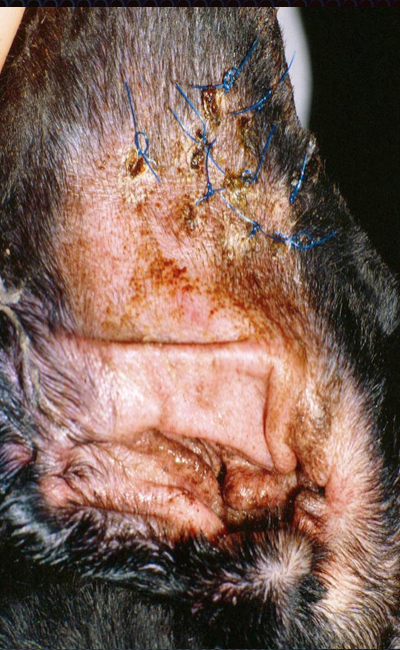Auricular hematomas occur from hemorrhage that develops between the 2
leaves of cartilage of the pinna. The hemorrhage can occur due to trauma to the
pinna from head shaking or scratching.
Inflammatory conditions of the ear canal, such as ear mites, foreign
bodies, or bacterial otitis may be the inciting cause.
Diagnosis
Aural hematomas are characteristic in appearance.(Fig.1,2)
 |
| Fig. 1: Aural hematoma in a cat |
 |
| Fig. 2: Aural hematoma in a young white tiger |
The pinna is enlarged and fluctuant. Differential diagnoses include acute allergic response causing severe swelling of the pinna, and neoplasia of the pinna. Aspiration of the mass reveals blood or serum. Rule out underlying ear canal problems by a thorough palpation of the ear canal and otoscopic exam. Also, thoroughly examine the animal for evidence of skin disease such as allergies, seborrhea, fleas, or pyoderma.
Treatment
Many methods have been described for treatment of aural
hematomas. Incision and drainage, drain tubes, and laser techniques have all
been described.(1-3) Medical management by simple drainage combined with either
systemic or local corticosteroid therapy has also been advocated. The advantage
of medical therapy or simple needle drainage is excellent
cosmetic result. However, incidence of recurrence with these treatments is
high. The advantage of incision and suture is a low rate of recurrence, but the
scaring of the pinna can cause poor cosmetic results.
The punch technique described here (Fig. 3) allows effective drainage
and very low incidence of recurrence.(4) The cosmetic results are also very
good since little scar tissue develops in the small incisions.
Surgical Technique
- Clip and prepare both sides of the pinna for aseptic surgery. Place a surgical sponge in the ear canal to prevent accumulation of blood.
- Use a skin biopsy punch (size 4-6 depending on the size of
the dog) to remove small plugs of skin and cartilage on the medial side of the pinna.(Fig. 4)

Creating punch incisions on the medial aspect of the pinna for drainage of aural hematoma. - Attempt to penetrate only the skin and 1 layer of the cartilage with the punch; however inadvertent removal a small section of both of the cartilage layers is not problematic.
- Make incisions about 0.5 – 1 cm apart and perform as many punches as necessary to drain the entire hematoma.
- Tack the skin edge of each incision with monofilament nylon, polypropylene, or Monocryl in a simple interrupted pattern.(Fig. 5) The size of suture can be 3-0 or 4-0 depending on the size of the animal. It is not necessary for the suture to penetrate full thickness through all layers of the pinna including the skin on both sides but the suture should incorporate both layers of cartilage and the skin on the medial surface.
 |
| Fig. 5: Suturing the edge of each punch incision with monofilament suture. |
Postoperative Care
Postoperatively, place a stockinette on the dog’s head to
protect the pinna and reduce bleeding. I prefer not to send dogs home with a full
bandage on the ear or head. Keep the dog from scratching the ear with an
Elizabethan collar. Remove sutures at 14 days.(Fig. 6)
If otitis externa or other skin
disorder is present, treat appropriately.
 |
| Fig. 6: Pinna of a dog 2 weeks after the punch technique for aural hematoma (Photo courtesy of Dr. Daniel Smeak) |
References
1. Pavletic MM Use of laterally placed vacuum
drains for management of aural
hematomas in five dogs. J Am Vet Med
Assoc. 2015 Jan 1;246(1):112-7.
2. Dye TL, Teague HD, Ostwald DA Jr, Ferreira SD. Evaluation of a technique using
the carbon dioxide laser for the treatment of aural hematomas. J Am Anim Hosp
Assoc. 2002 Jul-Aug;38(4):385-90.
3. Kagan KG Treatment of canine aural hematoma with an indwelling drain. J Am Vet Med
Assoc. 1983 Nov 1;183(9):972-
4. Smeak DD. Surgery of the ear canal and pinna. Saunders Manual
of Small Animal Practice, 3rd ed., Birchard and Sherding editors, Elsevier, 2006, pg. 582)
Blog Update: Dr. Birchard has published a new book: "Their Tails Kept Wagging", a collection of moving stories about pets with serious illness who survived. Click here for more information.



No comments:
Post a Comment